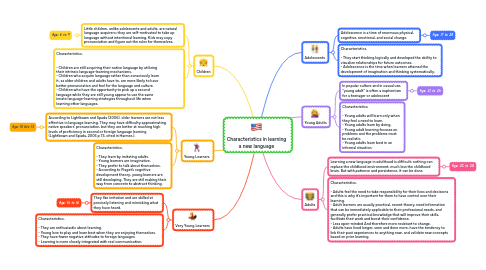Characteristics in learning a new language
von TONY CORTEZ


1. Children
1.1. Little children, unlike adolescents and adults, are natural language acquirers; they are self-motivated to take up language without intentional learning. Kids may copy pronunciation and figure out the rules for themselves.
1.1.1. Age: 6 to 9
1.2. Characteristics. - Children are still acquiring their native language by utilizing their intrinsic language-learning mechanisms. - Children who acquire language rather than consciously learn it, as older children and adults have to, are more likely to have better pronunciation and feel for the language and culture. - Children who have the opportunity to pick up a second language while they are still young appear to use the same innate language-learning strategies throughout life when learning other languages.
2. Young Learners
2.1. According to Lightbown and Spada (2006), older learners are not less effective in language learning. They may have difficulty approximating native speakers’ pronunciation, but they are better at reaching high levels of proficiency in second or foreign language learning (Lightbown and Spada, 2006 p 73, cited in Harmer,).
2.1.1. Age: 10 bto 13
2.2. Characteristics. - They learn by imitating adults. - Young learners are imaginative. - They prefer to talk about themselves. - According to Piaget’s cognitive development theory, young learners are still developing. They are still making their way from concrete to abstract thinking.
3. Very Young Learners
3.1. They like imitation and are skilled at precisely listening and mimicking what they have heard.
3.1.1. Age: 14 to 16
3.2. Characteristics. - They are enthusiastic about learning. - Young love to play and learn best when they are enjoying themselves. - They have fewer negative attitudes to foreign languages. - Learning is more closely integrated with real communication.
4. Adolescents
4.1. Adolescence is a time of enormous physical, cognitive, emotional, and social change.
4.1.1. Age: 17 to 20
4.2. Characteristics. - They start thinking logically and developed the ability to visualize relationships for future outcomes. - Adolescence is the time when learners attained the development of imagination and thinking systematically.
5. Young Adults
5.1. In popular culture and in casual use, “young adult” is often a euphemism for a teenager or adolescent
5.1.1. Age: 21 to 24
5.2. Characteristics. - Young adults will learn only when they feel a need to learn. - Young adults learn by doing. - Young adult learning focuses on problems and the problems must be realistic. - Young adults learn best in an informal situation.
6. Adults
6.1. Learning a new language in adulthood is difficult; nothing can replace the childhood environment, much less the childhood brain. But with patience and persistence, it can be done.
6.1.1. Age: 25 to 28
